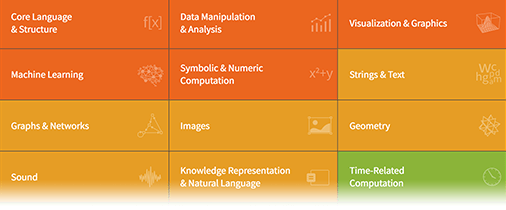Built-in Functions

The Wolfram Language has nearly 6,000 built-in functions. All have names in which each word starts with a capital letter:
Notes for Java programmers:
The built-in functions in the Wolfram Language are integrated into the language and follow a single uniform design, rather than being in different libraries.
Notes for Python programmers:
The Wolfram Language follows a single consistent uniform design with completely integrated built-in functions, rather than loading functionality through disparate modules and libraries with differing designs and conventions.
Arguments to functions are always separated by commas.
Notes for Java programmers:
Function arguments in the Wolfram Language use square brackets [...] rather than parentheses (...). The Wolfram Language reserves parentheses for grouping, which avoids ambiguity.
Notes for Python programmers:
In the Wolfram Language, function arguments use square brackets [...] rather than parentheses (...). Parentheses are reserved for grouping.
Typical built-in functions:
Complete guide:
Notes for Java programmers:
The Wolfram Language has vastly wider built-in functionality than Java.
Notes for Python programmers:
The Wolfram Language encompasses a wider breadth and depth of built-in functionality than Python—including features like ExternalEvaluate to integrate Python code—which makes it easier and faster to write code. You can access built-in Wolfram Language functions and symbols directly from Python by using language.wl from the Wolfram Client Library for Python.
QUICK REFERENCE: Guide to All Built-in Functions


